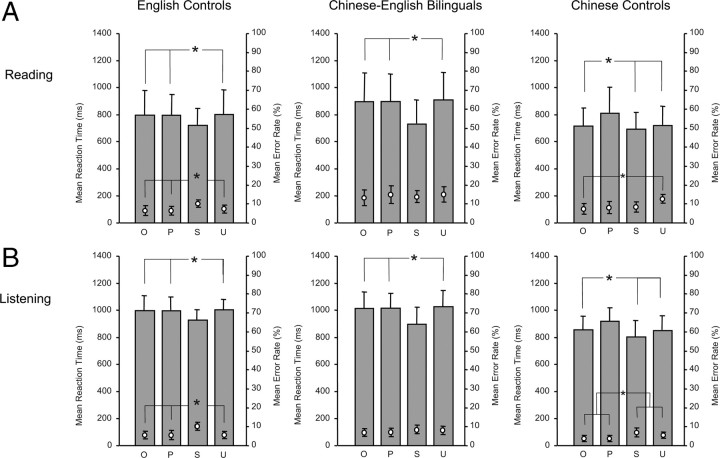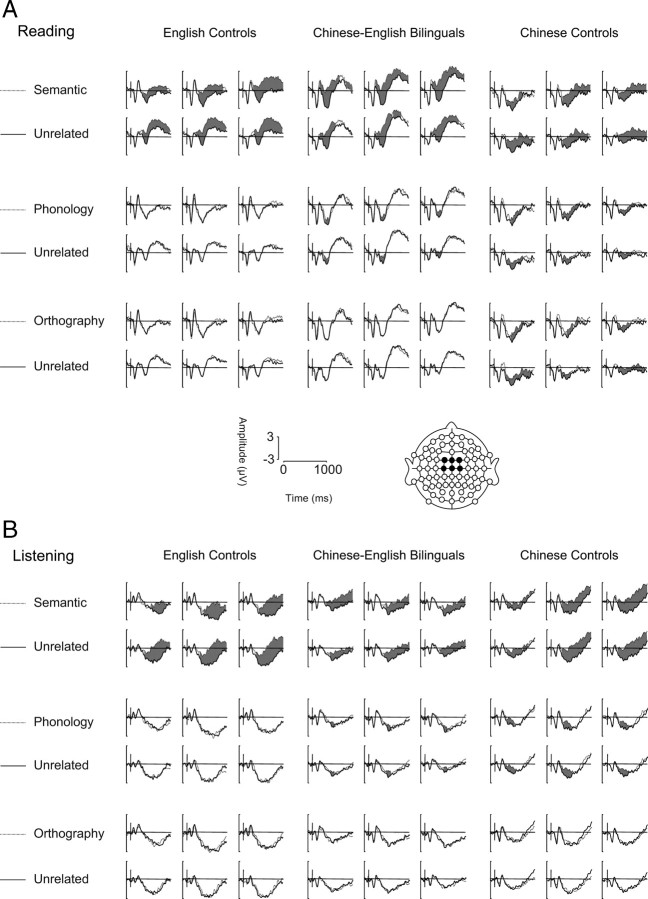Abstract
Bilingual individuals have been shown to access their native language while reading in or listening to their other language. However, it is unknown what type of mental representation (e.g., sound or spelling) they retrieve. Here, using event-related brain potentials, we demonstrate unconscious access to the sound form of Chinese words when advanced Chinese–English bilinguals read or listen to English words. Participants were asked to decide whether or not English words presented in pairs were related in meaning; they were unaware of the fact that some of the unrelated word pairs concealed either a sound or a spelling repetition in their Chinese translations. Whereas spelling repetition in Chinese translations had no effect, concealed sound repetition significantly modulated event-related brain potentials. These results suggest that processing second language activates the sound, but not the spelling, of native language translations.
Introduction
In the past decade, research on bilingual language processing has been marked by the discovery of cross-language interactions: When a bilingual processes one language, information in the other language is simultaneously accessed. Although evidence of nontarget language activation has been found during reading (Dijkstra et al., 1999, 2000b), listening (Spivey and Marian, 1999), and speech production (Colome, 2001; Jared and Kroll, 2001; Jared and Szucs, 2002), the nature of the information (e.g., spelling, sound, or meaning) that is accessed is undetermined. This is because previous studies have mostly focused on the spelling as the base of native language access (Dijkstra et al., 1998, 2000a; Van Heuven et al., 1998; De Groot et al., 2000). For example, bilingual performance in L2 has been shown to be differentiated by words that share spellings with translations in L1 (i.e., interlingual homographs or cross-language neighbors). The logic is that, if bilingual language processing is language-selective, bilingual participants' responses should be insensitive to words that can be read in two languages (e.g., stem meaning “voice” in Dutch), compared with words that are language specific. So far, experimental psychology and event-related potential (ERP) studies have provided compelling evidence that bilinguals are sensitive to the interlingual status of homographs across a range of tasks (Beauvillain and Grainger, 1987; Andrews, 1997; Elston-Güttler et al., 2005; Kerkhofs et al., 2006), suggesting the access to the spelling of native language translations.
Motivated by the theoretical viewpoint that the sound of words plays an important role in visual word recognition (Frost, 1998; Jared et al., 1999), a few studies have attempted to determine the magnitude of phonological activation in L1 during L2 word processing. In the same vein as interlingual homograph studies, such studies have made extensive use of interlingual homophones. In lexical decision tasks, for instance, bilingual participants display increased reaction time and error rate to words that sound the same in their two languages (Doctor and Klein, 1992; Dijkstra et al., 1999). Dijkstra et al. (1999) proposed that such inhibitory effects were attributable to competition between phonological representations in the target and nontarget languages, which are activated in parallel. Interestingly, other studies have reported facilitation effects for interlingual homophones using the same type of experimental tasks (Brysbaert et al., 1999; Lemhofer and Dijkstra, 2004).
One drawback of previous studies is that using words from two languages in the same experiment creates an artificial bilingual context, in which bilinguals are likely to activate lexical information from both their languages in parallel (Grosjean, 1998). Furthermore, the relative interdependence between spelling and sound naturally occurs in most European languages that have strong alphabetical overlap and similar grapheme–phoneme correspondence rules (Dijkstra et al., 1999; Schwartz et al., 2006). For instance, the word “roof,” which is spelled the same in both English and Dutch, also sounds very close in the two languages ([ru:f] vs [ro:f]). Similarly, words that sound the same in two languages often have substantial overlap in spelling (e.g., leaf vs “lief” in Dutch). Hence, the relative contribution of spelling and sound in cross-language interactions is difficult to tease apart.
Materials and Methods
The implicit priming paradigm.
Chinese, unlike English and other alphabetic languages, features no systematic correspondence between spelling and sound, and vice versa. We asked proficient Chinese–English bilinguals to judge whether or not English words presented in pairs were related in meaning (Table 1). Participants were unaware that some of the unrelated English words concealed either a sound or spelling repetition via translation in Chinese. Although the relatedness judgment task guaranteed access to meaning, testing participants exclusively in English prevented artificial coactivation of Chinese. Any effect of spelling and/or sound repetition in Chinese would then reveal implicit access to the native language during second language processing. We also tested native English and native Chinese control participants. Native speakers of English were expected to show the same effect of relatedness in meaning between words as bilinguals and no effect of spelling or sound repetition given their ignorance of Chinese. Native speakers of Chinese were presented with a Chinese version of the experiment and perceived spelling and sound repetitions explicitly. We used the repetition effect in the latter group as a guideline to interpret effects in the bilingual group.
Table 1.
Examples of stimuli used in the semantic-relatedness tasks
| Character repetition in Chinese (implicit) |
Semantic relatedness (explicit) |
||
|---|---|---|---|
| Sound repetition | Spelling repetition | Semantically related | Unrelated |
| Experience — Surprise | Accountant — Conference | Heaven — Hell | Sports — Wealth |
| Jing Yan — Jing Ya | Kuai Ji — Hui Yi | Tian Tang — Di Yu | Ti Yu — Cai Fu |
 — — 
|
 — — 
|
 — — 
|
 — — 
|
| SRE, 1.60 (±0.22) | SRE, 1.67 (±0.21) | SRE, 4.62 (±0.41) | SRE, 1.51 (±0.20) |
| SRC, 1.16 (±0.54) | SRC, 1.23 (±0.53) | SRC, 4.24 (±0.33) | SRC, 1.18 (±0.24) |
Each cell contains one example of an English word pair used in the semantic-relatedness task, its simplified Chinese translation, the corresponding Chinese Pin Yin (alphabetic transposition of the phonological form), and the mean semantic relatedness of the words in English (SRE) and Chinese (SRC). SD of the mean relatedness is given in parentheses. SRE of word pairs was rated on a scale from 1 to 5 by a group of 25 native English speakers, and the Chinese translations (SRC) were rated by a group of 27 native Chinese speakers. None of the evaluators was involved in the ERP experiments.
Difference in semantic relatedness was highly significant between semantically related word pairs and other conditions (p < 0.0001 for all pairwise comparisons), but there was no difference in semantic relatedness induced by either phonological or orthographic repetition in Chinese, whether it was hidden (English) or visible (Chinese) (p > 0.1 for all pairwise comparisons).
Participants.
A total number of 90 participants, 30 native English speakers, 30 native Chinese speakers, and 30 Chinese–English bilinguals volunteered for the experiment. All had normal or corrected-to-normal vision and self-reported normal hearing. They gave written consent to take part in the experiments that were approved by the ethics committee of the University of Wales. Participants were controlled for age (20–27 years), level of education (undergraduate and master students), and handedness (right) across groups. The bilingual participants were first exposed to English at the age of 12; by the time of testing, they were studying at a British university and had lived in the United Kingdom for a mean of 21.3 months (±3.25). All bilinguals used English in their everyday life and had an English proficiency score of 6 or 6.5 as measured by the International English Language Testing System (IELTS) (www.ielts.org/test_takers_information/what_is_ielts.aspx). The IELTS examination equally covers four fundamental language abilities (i.e., reading, listening, writing, and speaking). The maximum score being 9, the majority of candidates obtained between 4 and 7, 6.5 being what most English-speaking institutions require for non-native speakers.
Stimuli.
The 180 word pairs used were controlled across experimental conditions for lexical frequency, word concreteness, average numbers of letters and phonemes (Coltheart, 1981), and the level of semantic relatedness as rated by independent groups of native English and Chinese speakers. The repeated Chinese character, either orthographically or phonologically identical, always appeared in the same position within a word pair (Table 1). To avoid possible eye movements during the reading experiment, no English word had >11 letters and all Chinese translations featured two Chinese characters. To verify the Chinese translations used in the experiment, another group of 12 Chinese postgraduate and undergraduate students from Bangor University performed a translation task. These participants were randomly drawn from the same population as the bilingual participants tested in the study to minimize the differences attributable to levels of proficiency and everyday use of English. The “first translation” method (Tokowicz and Kroll, 2007) was used, in which participants provide the first translation that comes to their mind and cannot change their responses. If they did not know the translation of a given word, they were to skip that item. The responses in the questionnaire were then checked against translations used in the experiment, which were guided by an English–Chinese dictionary (XinHua English–Chinese Dictionary, 2002). In all conditions, participants generated >96% corrected translations, and there were no significant differences between conditions.
Tasks.
Participants viewed two blocks of 90 word pairs presented in a pseudorandomized order. After a prestimulus interval of 200 ms, the first word was flashed for 500 ms at fixation followed by the second word after a variable interstimulus interval of 500, 600, or 700 ms. In the listening experiment, the average length of English words was 4.7 ± 2 phonemes. There were no significant differences in the number of phonemes in pairwise comparisons between conditions (all values of p < 0.1). Participants heard digitized words pronounced by a native female speaker of English or Chinese. Prime words were presented within a 1000 ms time window followed by a target word after a variable interval of 500, 600, or 700 ms. No word was repeated in either of the studies. Participants were instructed to indicate whether the second word was related in meaning to the first by pressing keys. Response sides were fully counterbalanced between blocks and participants. At the end of each experiment, the participant was asked whether they had noticed any associations between the prime and target words other than the apparent semantic relatedness. They were specifically encouraged to consider both the English words and their Chinese translations. What we found was that none of the participants was able to report either the phonological or the orthographic repetition in Chinese translations and all of them were surprised when this implicit manipulation was revealed to them.
ERP recording.
Electrophysiological data were recorded in reference to Cz at a rate of 1 kHz from 64 Ag/AgCl electrodes placed according to the extended 10–20 convention. Impedances were kept <5 kΩ. Electroencephalogram activity was filtered on-line bandpass between 0.1 and 200 Hz and refiltered off-line with a 25 Hz, low-pass, zero-phase shift digital filter. Eye blinks were mathematically corrected, and remaining artifacts were manually dismissed. There was a minimum of 30 valid epochs per condition in every subject. Epochs ranged from −100 to 1000 ms after the onset of the second word. Baseline correction was performed in reference to prestimulus activity, and individual averages were digitally re-referenced to the global average reference. ERP data were collected simultaneously to behavioral data.
ERP data analysis.
Peak detection was performed automatically, time-locked to the latency of the peak at the electrode of maximal amplitude on the grand-average ERP. Temporal windows for peak detection were determined based on variations of the global field power measured across the scalp (Picton et al., 2000). Mean ERP amplitudes were subjected to a repeated-measures ANOVA with semantic relatedness (related/unrelated), character repetition (repeated/ unrepeated), and electrode (63 levels) as within-subject factors, and group as between-subject factor (native English controls/Chinese–English bilinguals) using a Greenhouse–Geisser correction where applicable. We also analyzed ERP data by means of pairwise millisecond-by-millisecond comparisons between conditions considered significant when differences were above threshold (p < 0.05) for >30 ms over a minimum of six clustered electrodes. Topographical analyses were based on mean amplitudes measured over 63 electrodes distributed over the entire scalp. Between-group comparisons involved calculating main-effect contrasts (semantically unrelated–semantically related and no character repetition–character repetition) and differences in mean amplitudes were entered into a between-subject repeated-measures ANOVA with 63 levels of electrodes. Interactions involving the electrode factor were controlled by using within-condition vector normalization (McCarthy and Wood, 1985).
Results
Behavioral results show no evidence of cross-language interactions. In the reading experiment, a significant main effect of condition was found in the English control participants on both the reaction times (RTs) (F(3,42) = 3.33; p < 0.05) and the error rates (F(3,42) = 6.75; p < 0.001). Post hoc analysis revealed that semantically related word pairs were responded to faster than other conditions (p < 0.05). No effect of repetition in Chinese was found in this group whether through spelling or sound repetition (all values of p > 0.1). The effect on error rates was attributable to an increase of the proportion of error for semantically related word pairs compared with other conditions (all values of p < 0.05). The same pattern of reaction time (F(3,42) = 18.38; p < 0.001) was found in the Chinese–English bilingual participants: semantically related word pairs were responded to faster than semantically unrelated word pairs (all values of p < 0.001), and there were no effects of spelling or sound repetitions concealed in Chinese translations (all values of p > 0.1). Finally, no effect of experimental condition was found on error rates in the Chinese–English bilinguals (F(3,42) = 0.36; p > 0.1).
In the Chinese control participants reading Chinese translations of the English words, there was a significant effect of condition on reaction times (F(3,42) = 11.29; p < 0.001) and a marginally significant effect on error rates (F(3,42) = 2.4; p = 0.08). However, the effect on reaction times was not attributable to semantically related words eliciting shorter RTs, but rather to sound repetition in Chinese eliciting longer RTs compared with other conditions (Fig. 1A) (all values of p < 0.01). With regards to error rates, unrelated word pairs yielded significantly higher error rates than word pairs featuring a spelling repetition in Chinese (p < 0.05), and no other difference was significant (all values of p > 0.1).
Figure 1.
Reaction times (bars; left axis) and error rates (bullets; right axis) for the English control group, the Chinese–English bilinguals, and the Chinese control group in reading (A) and listening (B) experiments. Conditions in which the English word pairs were semantically related, shared a phonological repetition or an orthographic repetition in Chinese translations, and unrelated are labeled S, P, O, and U, respectively. The stars indicate significant differences (p < 0.05). Error bars depict SEM in all cases.
The same overall pattern of behavioral performance prevailed in the listening experiment. English control participants (F(3,42) = 9.02; p < 0.001) and Chinese–English bilinguals (F(3,42) = 23.98; p < 0.001) all displayed the effect by semantic relatedness on reaction times. No effects of repetition in Chinese were observed in either of the two groups (all values of p > 0.1). The effect on error rates in the native English participants (F(3,42) = 23.33; p < 0.001) was again attributable to a significant increase in the number of errors made for semantically related word pairs (all values of p < 0.01), and no such effect was found in the Chinese–English bilinguals (all values of p > 0.1).
In the Chinese control participants, sound repetition in Chinese words significantly affected reaction times (F(3,42) = 4.5; p < 0.05) such that word pairs featuring a sound repetition were responded to slower than word pairs in all other conditions (Fig. 1B) (all values of p < 0.05). Unlike in the visual experiment, however, a significant effect on error rate was found (F(3,42) = 9.11; p < 0.01) between spelling and sound repetition on the one hand and semantically related and unrelated word pairs on the other, such that repetition priming reduced error rates (all values of p < 0.01).
ERPs dissociate activation in the sound from that of spelling in Chinese
In the reading experiment, a significant main effect of experimental condition was found in all three groups of participants. In the native English control participants (F(3,42) = 49.61; p < 0.001), post hoc analysis (least significant difference) revealed a significant difference in mean ERP amplitudes between the semantically related and semantically unrelated conditions beginning at 300 ms after stimulus (p < 0.001). Semantically related word pairs elicited reduced main amplitude in the N400 range compared with unrelated word pairs. A similar pattern of result was found in the Chinese bilinguals (F(3,42) = 27.54; p < 0.001), although the time course of the effect was more transient than in the English controls. Chinese control participants (F(3,42) = 5.22; p < 0.05) who read the Chinese translations also showed a prolonged effect of semantic relatedness on mean ERP amplitude in the same direction. There was no significant variation in the scalp topography of these effects across groups.
The hidden sound repetition in Chinese translations had no effect in the English control participants (p > 0.1). In comparison, Chinese–English bilinguals showed a significant effect of sound repetition in Chinese translations while reading English words: Mean N400 amplitude was reduced for English word pairs that involved a sound repetition in Chinese translations compared with word pairs that shared spelling repetition in Chinese and unrelated word pairs (all values of p < 0.01) (Fig. 2A). This sound repetition effect, which appeared within the N400 temporal window of semantic effects (i.e., between 310 and 420 ms), explains the significant condition-by-group interaction (F(1,28) = 3.91; p < 0.05) that was found between native English participants and Chinese–English bilinguals, the two groups that were both exposed the English stimuli.
Figure 2.
ERP results for the English control group, the Chinese–English bilinguals, and the Chinese control group in reading (A) and listening (B) experiments. Waveforms depict brain potential variations from six electrodes (FC1, FC2, FCz, C1, C2, Cz). The schematic head shows electrode locations. The shaded areas represent significant differences between conditions (e.g., p < 0.05) over a minimal period of 30 ms.
In the native Chinese control participants, the same pattern of sound repetition effect was found as that seen in the bilinguals. Compared with the unrelated condition, overt repetition in the sound of Chinese characters reduced ERP amplitude between 260 and 510 ms (p < 0.001), but the amplitude modulation induced by semantic relatedness was greater and more durable than that elicited by character repetition, mirroring the pattern found in Chinese–English bilinguals as well as its topographical distribution. With regard to the spelling repetition in Chinese translations, ERPs of the English control participants were insensitive to this manipulation (p > 0.1), showing a pattern of variations comparable with the baseline comparison of the unrelated word pairs. Critically, the Chinese–English bilinguals who reacted to implicit sound repetitions in Chinese were insensitive to implicit spelling repetitions (p > 0.1). However, explicit repetition in the visual form of Chinese characters modulated ERP amplitude in Chinese control participants: Mean ERP amplitude was significantly reduced between 250 and 660 ms (p < 0.05) when Chinese controls read Chinese target words that shared one character with the prime words compared with target words that were unrelated to the prime words.
Listening to and reading words yielded the same qualitative results in bilinguals
In the listening experiment, a semantic relatedness effect was found in all three groups of participants (Fig. 2B). In the native English control participants, semantically related word pairs elicited smaller N400 amplitude than unrelated word pairs (p < 0.0001), and this difference was found to be the only explanation for the difference between the four experimental conditions (F(3,42) = 8.71; p < 0.001). The Chinese–English bilinguals (F(3,42) = 5.23; p < 0.05) and Chinese control participants (F(3,42) = 12.77; p < 0.001) showed the same pattern of semantic effect (all values of p < 0.05).
In the native English control participants, no difference was found between word pairs that featured a sound repetition in Chinese translations and pairs of unrelated words (p > 0.1). In the Chinese–English bilinguals, however, the same comparison revealed a significant difference. Implicit sound repetition in Chinese translations reduced mean ERP amplitude between 360 and 450 ms compared with words pairs that involved a spelling repetition in Chinese and were unrelated (all values of p < 0.05), accounting for the significant condition-by-group interaction (F(1,28) = 4.17; p < 0.05). In the native Chinese control participants, again, explicit overlap in the sound of Chinese significantly modulated the N400 amplitude between 240 and 500 ms (p < 0.05).
When comparing word pairs that featured a spelling repetition in Chinese translations with unrelated word pairs, no difference was found in either Chinese–English bilinguals or Chinese control participants (all values of p > 0.1). ERP waveforms of the two conditions overlapped closely throughout the analysis window. In the Chinese control participants, in particular, auditory presentation of Chinese words did not trigger spelling repetition priming, contrasting with the significant effect of spelling repetition in the reading experiment.
Discussion
In the present study, for the first time, we specify the nature of native language information—orthography or phonology—that is spontaneously accessed when bilingual individuals read or listen to their second language. This was achieved by examining brain potentials elicited by English word pairs that concealed independently spelling or sound repetition in their Chinese translations. Although previous studies have failed to fully dissociate these two factors because of the intrinsic links between spelling and sound in alphabetic writing systems, the study of Chinese–English bilinguals using an implicit priming paradigm via L1 translations offers an ideal context in which the contribution of each of the two factors can be tested separately.
Behavioral results collected during ERP recording seemed to indicate that Chinese–English bilinguals are insensitive to the implicit manipulations in Chinese in either the visual or the auditory modality. Semantically related word pairs yielded faster reaction times in the Chinese–English bilinguals and both the control groups. This effect might be attributable to the fact that positive responses are made faster than negative ones. However, despite an overall increase in response latency and error rates compared with native English participants, Chinese–English bilinguals displayed a “native-like” pattern of performance without obvious signs of L1 activation when processing L2 words.
By contrast, when Chinese control participants read in and listened to words presented in Chinese, sound repetition induced a significant increase in reaction time, that is, a negative priming effect. Such effect was not seen for spelling repetition, which suggests that lexical access in Chinese spontaneously activates phonological codes and that it interferes with semantic decision processes (Frost, 1998). The absence of such an effect in the bilingual participants replicates results of our previous study in which repetitions in Chinese translations involved both spelling and sound (Thierry and Wu, 2007).
The analysis of the ERP data revealed priming effects that were invisible in the behavioral data of bilingual participants. In the reading experiment, Chinese–English bilinguals showed a significant priming effect by sound repetition in Chinese translations in the form of amplitude reduction at the N400 component. However, no effects were found for spelling repetition via translation in L1. Given that (1) bilingual participants were unable to report the hidden character repetition in Chinese translations at debriefing, and (2) behavioral data failed to show in bilinguals the interference pattern observed in Chinese controls, it is likely that access to L1 was unconscious in bilinguals tested in L2 (see Materials and Method). The N400 modulation was of greater magnitude and lasted longer for semantic relatedness than implicit sound repetition. This ERP priming profile is consistent with that of the classical N400 known to index semantic integration (Kutas and Hillyard, 1980, 1984), but also phonological and orthographic priming during word comprehension (Grainger et al., 2006; Holcomb and Grainger, 2006).
Results from the English and Chinese control participants confirmed the interpretation of the N400 modulation as a consequence of accessing phonological representations in L1. Native English speakers responded only to semantic priming. This shows that (1) the experimental task (i.e., semantic relatedness judgment) oriented participants onto the processing of word meaning as planned, and (2) the implicit manipulation in Chinese did not introduce spurious semantic or lexical differences between conditions in the English material.
Chinese control participants who read Chinese words showed a priming effect of explicit sound repetition very similar in magnitude and duration to that found in Chinese–English bilinguals reading English words, but smaller and less durable than the semantic priming effects. The latter pattern is consistent with previous reports of weaker variations in the N400 range elicited by orthographic and/or phonological overlap between words compared with semantic relationships (Rugg and Barrett, 1987; Perrin and García-Larrea, 2003; Thierry and Wu, 2007). Moreover, the similar profile of sound repetition priming in Chinese across participant groups suggests that the modulation of the N400 reflects the same mechanism whether priming is explicit or implicit.
Bilingual word processing was further examined in a replication of the visual experiment in the auditory modality. Experimental psychology has made a case for the activation of spelling representations during spoken word processing in monolinguals (Ziegler and Ferrand, 1998; Perre and Ziegler, 2008). For instance, words that end with a consistent rhyme (e.g., /ΛK/ sounding like “uck”) are recognized faster and more accurately than those that end with an inconsistent rhyme (e.g., /aIt/ can be spelled as “ight,” “ite,” or “yte”) during spoken word recognition (Ziegler and Ferrand, 1998). Recent ERP studies have described an electrophysiological correlate of orthographic consistency within the N400 window in a lexical decision task (Perre and Ziegler, 2008) and in a semantic categorization task when participants are not encouraged to access the spelling of words strategically (Pattamadilok et al., 2009). Since auditory perception of words can be influenced by spelling in monolinguals, it remains theoretically plausible that listening to words in L2 may be associated with implicit activation of the spelling of L1 translations.
However, the results of our auditory experiment excluded this possibility, because we found evidence for the activation of L1 sound forms but not spelling representations in both the listening and the reading experiments.
Even in the case of native Chinese participants listening to Chinese words, the overt perception of a repeated Chinese character failed to elicit significant priming based on spelling. This suggests that the repetition priming via Chinese spelling found in the reading experiment reflects a modality-specific, bottom-up process in visual word recognition. By contrast, the robustness of sound priming effects across modalities in both the Chinese control and the Chinese–English bilingual groups suggests that activation of sound representations is a spontaneous correlate of language processing, whether individuals process their second or their native language. This idea is fully consistent with our behavioral results: Spelling repetition had no effect in native Chinese control participants and reaction times were significantly longer for sound repetition in both the reading and the listening experiments.
The dissociation between access to spelling and sound representations in the native language established here not only provides a new interpretational basis to explain inconsistencies in previous studies of bilingual language comprehension but also affords a novel perspective on neuroimaging evidence that studies that mixed these two factors could not shed light on.
Functional neuroimaging studies have often reported activation in shared or partially overlapping brain regions when comparing native with second language processing (Kim et al., 1997; Chee et al., 2000, 2003; Tan et al., 2003). Although commonly activated areas are generally interpreted as the neural substrates underlying conceptual processing—arguably shared between languages—the existence of “language-specific” brain regions is a matter of controversy. The evidence of cross-language interactions reported here implies that “language-specific” cortical activations extend well beyond the level of conceptual processing because the processing of second language words appears to automatically trigger activation of native language representations at lexical and possibly sublexical levels. Furthermore, our procedure allows us to distinguish the type of information in the native language that is associated with (sound) and dissociated from (spelling) word processing in the second language and, therefore, provides an interpretative framework for the characterization of functional language dependency in the bilingual brain.
To conclude, previous studies on bilingual language processing have demonstrated parallel activation in either the spelling or the sound of two languages, but they have been unable to directly compare the two factors because of the nature of European language writing systems. The present study solved this problem by concealing fully dissociated spelling and sound repetitions in Chinese translations while orienting participants to the meaning of words presented exclusively in English. In the absence of direct, overt manipulations of phonology or orthography, the current method circumvents the biases introduced by physical repetitions (e.g., homophones), by both physical repetitions and orthographic aberrations (e.g., homographs), or by task-specific effects. The implicit nature of the manipulation creates a more stringent testing context in which Chinese sound (or spelling) is accessed only if it was the spontaneous correlate(s) for processing words in English. The finding that bilingual participants activate the sound, but not the spelling, of translations in their native language specifies the nature of cross-language interaction in bilinguals and provides a framework to interpret functional neuroimaging of language in the brain. Future studies looking at bilingual individuals with different language combinations and levels of proficiency will shed more light on these conclusions.
Footnotes
This work was supported by Economic and Social Research Council Grant ES/E024556/1 and European Research Council Grant ERC-StF-209704. We thank David Green, Steve Luck, Clara Martin, Bob Rafal, Steve Tipper, and Marilyn Vihman for useful discussions and Mark Roberts for technical assistance.
References
- Andrews S. The effects of orthographic similarity on lexical retrieval: resolving neighborhood conflicts. Psychon Bull Rev. 1997;4:439–461. [Google Scholar]
- Beauvillain C, Grainger J. Accessing interlexical homographs: some limitations of a language-selective access. J Mem Lang. 1987;26:658–672. [Google Scholar]
- Brysbaert M, Van Dyck G, Van de Poel M. Visual word recognition in bilinguals: evidence from masked phonological priming. J Exp Psychol Hum Percept Perform. 1999;25:137–148. doi: 10.1037//0096-1523.25.1.137. [DOI] [PubMed] [Google Scholar]
- Chee MW, Weekes B, Lee KM, Soon CS, Schreiber A, Hoon JJ, Chee M. Overlap and dissociation of semantic processing of Chinese characters, English words, and pictures: evidence from fMRI. Neuroimage. 2000;12:392–403. doi: 10.1006/nimg.2000.0631. [DOI] [PubMed] [Google Scholar]
- Chee MW, Soon CS, Lee HL. Common and segregated neuronal networks for different languages revealed using functional magnetic resonance adaptation. J Cogn Neurosci. 2003;15:85–97. doi: 10.1162/089892903321107846. [DOI] [PubMed] [Google Scholar]
- Colome A. Lexical activation in bilinguals' speech production: language-specific or language-independent? J Mem Lang. 2001;45:721–736. [Google Scholar]
- Coltheart M. The MRC psycholinguistic database. Q J Exp Psychol. 1981;33:497–505. [Google Scholar]
- De Groot AMB, Delmaar P, Lupker SJ. The processing of interlexical homographs in translation recognition and lexical decision: support for non-selective access to bilingual memory. Q J Exp Psychol. 2000;53:397–428. doi: 10.1080/713755891. [DOI] [PubMed] [Google Scholar]
- Dijkstra T, Van Jaarsveld H, Ten Brinke S. Interlingual homograph recognition: effects of task demands and language intermixing. Biling Lang Cogn. 1998;1:51–66. [Google Scholar]
- Dijkstra T, Grainger J, Van Heuven WJB. Recognition of cognates and interlingual homographs: the neglected role of phonology. J Mem Lang. 1999;41:496–528. [Google Scholar]
- Dijkstra T, De Bruijn ERA, Schriefers H, Ten Brinke S. More on interlingual homograph recognition: language mixing versus explictness of instruction. Biling Lang Cogn. 2000a;3:69–78. [Google Scholar]
- Dijkstra T, Timmermans M, Schriefers H. On being blinded by your other language: effects of task demands on interlingual homograph recognition. J Mem Lang. 2000b;42:455–464. [Google Scholar]
- Doctor EA, Klein D. Phonological processing in bilingual word recognition. In: Harris RJ, editor. Cognitive processing in bilinguals. Amsterdam: Elsevier; 1992. pp. 237–252. [Google Scholar]
- Elston-Güttler KE, Gunter TC, Kotz SA. Zooming into L2: global language context and adjustment affect processing of interlingual homographs in sentences. Brain Res Cogn Brain Res. 2005;25:57–70. doi: 10.1016/j.cogbrainres.2005.04.007. [DOI] [PubMed] [Google Scholar]
- Frost R. Toward a strong phonological theory of visual word recognition: true issues and false trails. Psychol Bull. 1998;123:71–99. doi: 10.1037/0033-2909.123.1.71. [DOI] [PubMed] [Google Scholar]
- Grainger J, Kiyonaga K, Holcomb PJ. The time course of orthographic and phonological code activation. Psychol Sci. 2006;17:1021–1026. doi: 10.1111/j.1467-9280.2006.01821.x. [DOI] [PMC free article] [PubMed] [Google Scholar]
- Grosjean F. Studying bilingualism: methodological and conceptual issues. Biling Lang Cogn. 1998;1:131–149. [Google Scholar]
- Holcomb PJ, Grainger J. On the time course of visual word recognition: an event-related potential investigation using masked repetition priming. J Cogn Neurosci. 2006;18:1631–1643. doi: 10.1162/jocn.2006.18.10.1631. [DOI] [PMC free article] [PubMed] [Google Scholar]
- Jared D, Kroll JF. Do bilinguals activate phonological representations in one or both of their languages when naming words? J Mem Lang. 2001;44:21–31. [Google Scholar]
- Jared D, Szucs C. Phonological activation in bilinguals: evidence from interlingual homograph recognition. Biling Lang Cogn. 2002;5:225–239. [Google Scholar]
- Jared D, Levy BA, Rayner K. The role of phonology in the activation of word meanings during reading: evidence from proofreading and eye movements. J Exp Psychol Gen. 1999;128:219–264. doi: 10.1037//0096-3445.128.3.219. [DOI] [PubMed] [Google Scholar]
- Kerkhofs R, Dijkstra T, Chwilla DJ, de Bruijn ER. Testing a model for bilingual semantic priming with interlingual homographs: RT and N400 effects. Brain Res. 2006;1068:170–183. doi: 10.1016/j.brainres.2005.10.087. [DOI] [PubMed] [Google Scholar]
- Kim KH, Relkin NR, Lee KM, Hirsch J. Distinct cortical areas associated with native and second languages. Nature. 1997;388:171–174. doi: 10.1038/40623. [DOI] [PubMed] [Google Scholar]
- Kutas M, Hillyard SA. Reading senseless sentences: brain potentials reflect semantic incongruity. Science. 1980;207:203–205. doi: 10.1126/science.7350657. [DOI] [PubMed] [Google Scholar]
- Kutas M, Hillyard SA. Brain potentials during reading reflect word expectancy and semantic association. Nature. 1984;307:161–163. doi: 10.1038/307161a0. [DOI] [PubMed] [Google Scholar]
- Lemhofer K, Dijkstra T. Recognizing cognates and interlingual homographs: effects of code similarity in language specific and generalized lexical decision. Mem Cogn. 2004;32:533–550. doi: 10.3758/bf03195845. [DOI] [PubMed] [Google Scholar]
- McCarthy G, Wood CC. Scalp distributions of event-related potentials: an ambiguity associated with analysis of variance models. Electroencephalogr Clin Neurophysiol. 1985;62:203–208. doi: 10.1016/0168-5597(85)90015-2. [DOI] [PubMed] [Google Scholar]
- Pattamadilok C, Perre L, Dufau S, Ziegler JC. On-line orthographic influences on spoken language in a semantic task. J Cogn Neurosci. 2009;21:169–179. doi: 10.1162/jocn.2009.21014. [DOI] [PubMed] [Google Scholar]
- Perre L, Ziegler JC. On-line activation of orthography in spoken word recognition. Brain Res. 2008;1188:132–138. doi: 10.1016/j.brainres.2007.10.084. [DOI] [PubMed] [Google Scholar]
- Perrin F, García-Larrea L. Modulation of the N400 potential during auditory phonological/semantic interaction. Brain Res Cogn Brain Res. 2003;17:36–47. doi: 10.1016/s0926-6410(03)00078-8. [DOI] [PubMed] [Google Scholar]
- Picton TW, van Roon P, Armilio ML, Berg P, Ille N, Scherg M. The correction of ocular artifacts: a topographic perspective. Clin Neurophysiol. 2000;111:53–65. doi: 10.1016/s1388-2457(99)00227-8. [DOI] [PubMed] [Google Scholar]
- Rugg MD, Barrett SE. Event-related potentials and the interaction between orthographic and phonological information in a rhyme-judgment task. Brain Lang. 1987;32:336–361. doi: 10.1016/0093-934x(87)90132-5. [DOI] [PubMed] [Google Scholar]
- Schwartz AI, Kroll JF, Diaz M. Reading words in Spanish and English: mapping orthography to phonology in two languages. Lang Cogn Process. 2006;21:1–24. [Google Scholar]
- Spivey MJ, Marian V. Cross talk between native and second languages: partial activation of an irrelevant lexicon. Psychol Sci. 1999;10:281–284. [Google Scholar]
- Tan LH, Spinks JA, Feng CM, Siok WT, Perfetti CA, Xiong J, Fox PT, Gao JH. Neural systems of second language reading are shaped by native language. Hum Brain Mapp. 2003;18:158–166. doi: 10.1002/hbm.10089. [DOI] [PMC free article] [PubMed] [Google Scholar]
- Thierry G, Wu YJ. Brain potentials reveal unconscious translation during foreign-language comprehension. Proc Natl Acad Sci U S A. 2007;104:12530–12535. doi: 10.1073/pnas.0609927104. [DOI] [PMC free article] [PubMed] [Google Scholar]
- Tokowicz N, Kroll JF. Number of meanings and concreteness: consequences of ambiguity within and across languages. Lang Cogn Process. 2007;22:727–779. [Google Scholar]
- Van Heuven WJB, Dijkstra T, Grainger J. Orthographic neighborhood effects in bilingual word recognition. J Mem Lang. 1998;39:458–483. [Google Scholar]
- Ziegler JC, Ferrand L. Orthography shapes the perception of speech: the consistency effect in auditory word recognition. Psychon Bull Rev. 1998;5:683–689. [Google Scholar]




